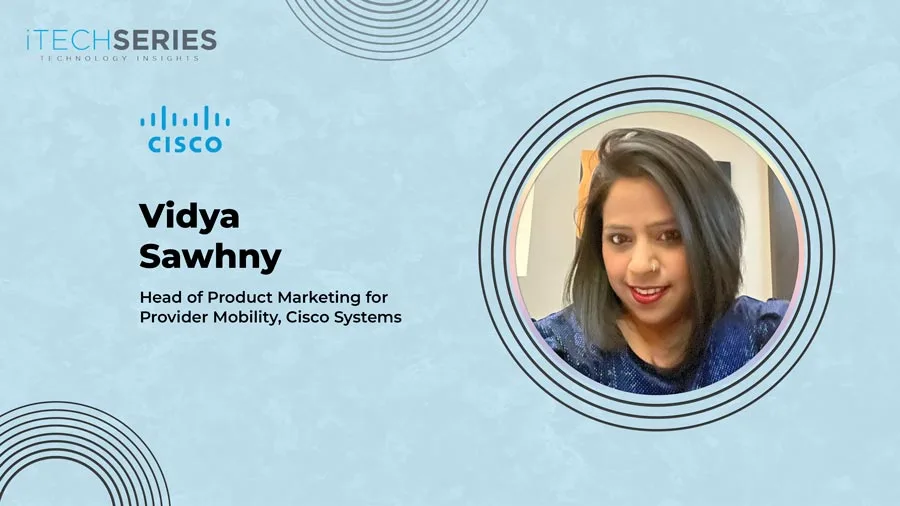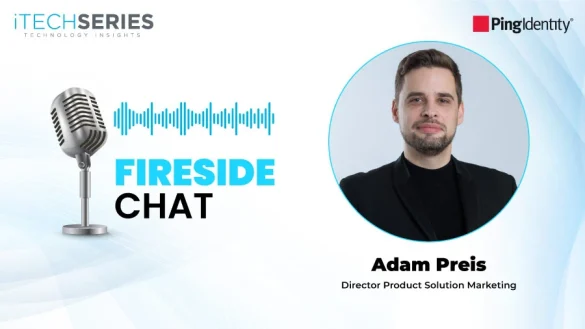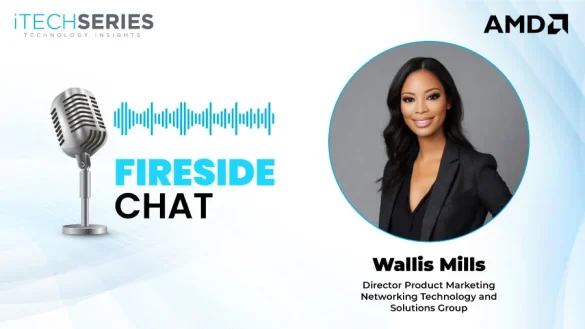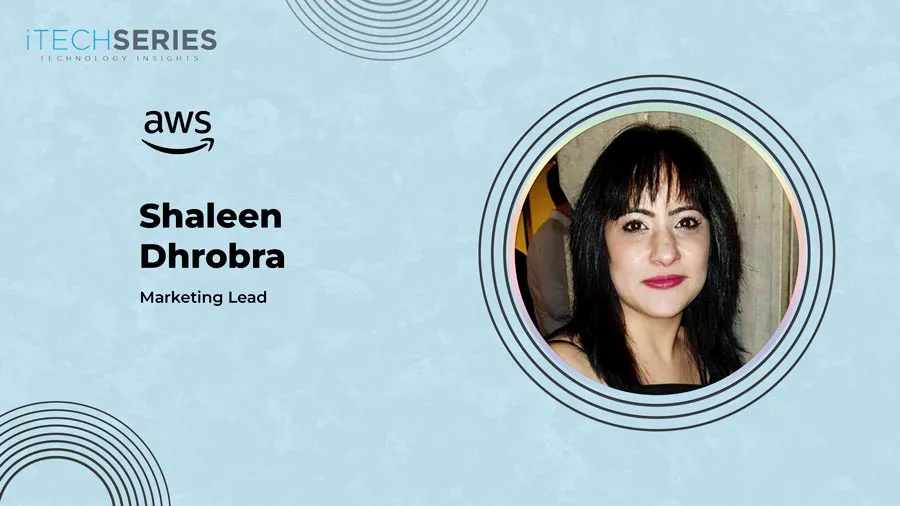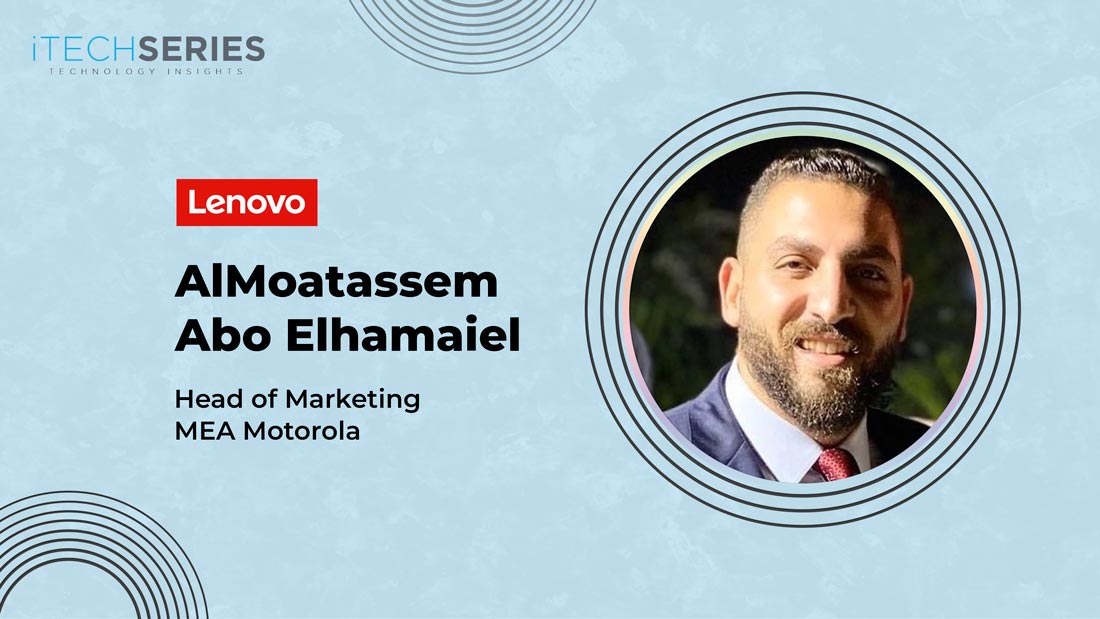In this exclusive interview, Vidya Sawhny, Head of Product Marketing for Provider Mobility at Cisco Systems, shares her 19+ year journey driving innovation, AI, and mobility solutions. From scaling global GTM strategies to launching multi-agentic AI frameworks, hybrid cloud solutions, data center and automation technologies, she discusses how storytelling, thought-leadership, and customer-centric marketing deliver measurable business impact and shape the future of tech marketing.
It’s a pleasure to have you, Vidya. Could you tell us more about yourself and your marketing journey?
Thank you for the invitation! It’s a pleasure to be here. My journey in marketing has been shaped by a curiosity about technology and a passion for storytelling that drives measurable business impact. Over 19+ years, I’ve led global product and digital marketing for multi-billion-dollar businesses like Cisco, Hewlett Packard, and Sun Microsystems, and worked with PR firms and consultancies such as Ketchum and Burson-Marsteller. My focus has always been at the intersection of innovation and go-to-market excellence, most recently launching predictive and prescriptive AI technologies, multi-agentic frameworks, and hybrid cloud solutions with partners like Google, Amazon, and Microsoft. I translate complex technologies into simple, compelling narratives that resonate with technical and business decision-makers and C-Suite executives—ultimately moving the market. My efforts have directly contributed to $1B+ in portfolio growth, accelerating pipeline by over 40% YoY and improving content engagement 3x across digital channels.
Over the past year and a half, I served as Head of Product Marketing for Cisco’s Crosswork Automation and AI Portfolio and most recently became Product Marketing Lead for Cisco’s Provider Mobility Business—a $650 M business driving Cisco’s Mobility Platform, IoT Control Center with Connected Cars, Private 5G, and more. Before pivoting to mobility and automation, I spent over seven years in Customer Experience and Professional Services within Cisco, leading Corporate Marketing and Demand Generation. I’ve been recognized with several awards, including the US Ketchum Excellence in PR Research Award facilitated at Yale with a research grant and internship. I’ve developed expertise across cloud computing, data center networking, security, customer experience, automation, and mobility. AI remains top of mind, and I’ve contributed to launching new AI agents, multi-agent frameworks, and API-driven innovations to accelerate business value. At the heart of my career is connecting strategy to measurable outcomes—driving demand, accelerating go-to-market initiatives, and delivering ROI. Whether leading global launches, forging hyperscaler partnerships, or mentoring high-performing teams, my focus remains on delivering quantifiable business impact while shaping the future of technology marketing.
You’ve led GTM efforts for multi-billion-dollar portfolios—how do you approach building a go-to-market strategy that scales across global markets and complex technologies like AI, automation, and cloud?
A scalable GTM strategy starts with a sharp focus on customer needs, with deep alignment across product, sales, customer success, and partner teams. My approach is rooted in building a strong messaging and positioning framework tailored to targeted personas, ranging from C-suite executives, managers, technical and engineering leaders, and developers in global markets. I start by defining the value proposition, then operationalizing it through differentiated content, localized campaigns, and aligned with sales enablement strategies. My approach is rooted in three core pillars:
- Persona-centric Messaging: I start with market research, industry drivers, and customer challenges to create messaging frameworks that resonate with both technical and business stakeholders. For example, with Cisco’s Crosswork Network Automation portfolio, we launched a new multi-agentic framework and predictive and preventive AI agents in February and June 2025 by building a cohesive strategy that included messaging guides, customer-facing collateral, digital presence, demo videos, executive decks, and press engagement—all synchronized to leverage across regional teams.
- Global-Ready, Regionally Relevant: I work closely with geo-marketing leads to balance consistency and localization. When we launched the automation platform and new AI capabilities, we provided global toolkits but enabled local storytelling, leading to regional campaign lift in EMEA by 40% and 50% content adoption in APJC.
- Integrated Execution and Feedback Loops: I embed real-time performance tracking and enable feedback from sellers and customers back into campaign iterations, shortening time-to-market and increasing ROI.
Ultimately, the key to scaling GTM for complex technologies like AI, automation, and public/private/hybrid cloud, et al. lies in translating innovation into clear, compelling value for customers while ensuring regional relevance and continuous iteration. By aligning strategy with execution and metrics, I’ve consistently driven impact-contributing millions in revenue, building sales pipelines, and enabling Cisco and previously HP to lead in highly competitive markets.
How do you see emerging technologies like multi-agentic frameworks and prescriptive AI reshaping product marketing and the customer experience landscape?
Emerging technologies like AI and multi-agentic frameworks are transforming how we define customer value and deliver experiences. These innovations are not just product features—they shift the very nature of the customer promise from reactive support to predictive and autonomous outcomes.
Key focus areas from a product marketing perspective:
- It means shifting from reactive feature promotion to proactive storytelling around real-time intelligence, tangible business benefits, and enhanced customer experiences. For instance, in my recent launch of Cisco’s multi-agentic framework within Crosswork Automation, we introduced AI agents capable of identifying toxic network patterns and preventing configuration drift, and it wasn’t just about tech. It was about how customers can transform their networks proactively to achieve business resiliency, operational efficiency, and drive towards an industry-leading phenomenon around autonomous networking, achieved by averting potential network downtime and outages and saving millions of dollars in revenue.
- Showcasing value through live simulations, AI, and intelligent demos, shifting from static content to real-time decision support.
- Offering a more consultative role, helping customers see how emerging AI technologies directly solve their evolving pain points.
- AI-led journeys and micro-segmentation allow us to deliver tailored content paths, increasing engagement rates by 3–5x.
- We’re also exploring intent-driven web experiences that adapt based on user interaction patterns, supported by AI-driven CMS and telemetry tools.
“The key to scaling GTM for AI, automation, and cloud lies in translating innovation into clear, compelling value for customers while ensuring regional relevance and continuous iteration.”
Can you share a campaign or product launch you led that was particularly challenging but ultimately successful?
One of the most complex yet rewarding campaigns was the Hybrid Cloud launch I led at Cisco in partnership with Google, Microsoft, and Amazon, driving each partnership separately. Coordinating across multiple hyperscalers, aligning on shared messaging, the end-to-end marketing strategy, and executing a multi-channel campaign demanded high agility and scaled collaboration. We had to navigate competitive sensitivities, variable readiness levels across regional teams, and differing customer maturity in cloud adoption. Despite the complexity, we successfully generated a $100M sales pipeline and achieved a 15% bookings conversion within the first 9 months. It required a deep understanding of both the technical architecture and the broader market narrative around multicloud and hybrid cloud technologies, partnership alignment, unique as well as competing features and functionalities, and deep-dive future technology innovations.
Delivered on the marketing motion through a two-part approach: From an awareness and thought-leadership standpoint, I spearheaded joint-partnership announcements, press and analyst engagements, strategic content, thought-leadership opportunities across global theaters, videos, events, and regional roadshows. From a GTM and demand generation perspective, targeted upsell and cross-sell campaigns, plus new logos leveraging deep partnership alliances. In parallel, I led sales training and enablement with tailored assets, engaging customer stories, competitive proof points, and regional campaigns across channels helped accelerate engagement and adoption.
The success of this initiative reinforced my belief in meticulous planning, cross-functional collaboration, and the importance of storytelling that’s both technically sound and emotionally resonant.
How do you align large-scale demand generation campaigns with sales enablement and the broader customer journey to ensure consistent pipeline growth?
Alignment is achieved by building and mapping an end-to-end GTM flywheel that connects awareness, engagement, adoption, and conversion. For every demand generation initiative, I ensure we create corresponding sales assets: competitive battle cards, persona-based messaging, use-case demos, and enablement playbooks.
At Cisco, this was key to driving $12M in revenue for Cisco’s Business Critical Services and building a $120M+ pipeline for security and multicloud solutions. We worked closely with sales to embed campaign insights into SFDC, conducted enablement sessions, and used metrics like lead conversion, pipeline velocity, and engagement rates to continuously refine the process. It’s about ensuring marketing and sales aren’t running parallel but cohesively integrated.
Some specific guidelines and best practices entail:
- Sales Collaboration: Co-create value propositions and pitch narratives with sales engineering and field teams. For example, our AI Connectivity campaign included tailored sales decks, demo scripts, and competitive positioning, increasing seller usage by 70%.
- Lifecycle Content Strategy: Map content to the full journey, from thought-leadership and explainer videos to ROI calculators and post-sale success kits. It was done right, and this approach helped improve MQL-to-SQL conversion rates by 35%.
- Integrated Campaign Cadence: Orchestrate content syndication, email nurture, paid search, and webinar follow-ups through automation tools like SFDC, Eloqua, or others of choice, resulting in a 30% lift in marketing-sourced pipeline YoY.
Sales enablement is not an afterthought—it’s embedded from the start. Every campaign includes a sales playbook, battle cards, competitive positioning, and modular assets that sales can easily tailor. We also invest in feedback loops—tracking bookings, campaign ROI, and seller sentiment—to refine our approach continuously. Importantly, feedback is generated from each region separately to factor in and tailor to regional sentiment and geographic dynamics. The result is a seamless experience for the customer and a more empowered salesforce that can confidently convert leads into wins and revenue!
In today’s saturated market, how do you design thought leadership programs that stand out and genuinely build brand credibility?
To cut through the noise, thought leadership must be insight-led and customer-anchored. I build programs around real-world challenges and solution impact, not product specs.
In a saturated market, designing thought leadership programs means anchoring them in authentic expertise and customer relevance. For Cisco’s Advisory and Multicloud Services portfolio, I drove visibility by creating a structured thought-leadership campaign rooted in clear messaging frameworks and a strong value proposition. We implemented a calendarized program spanning executive blogs on multicloud trends, skills gaps, and services value, alongside podcasts, TheCube interviews with SiliconAngle, and participation in IDC MarketScape and Gartner studies. In 2018, I spearheaded Cisco’s participation in the IDC MarketScape Study, highlighting cloud expertise, partnership innovations, and competitive differentiations, improving Cisco’s ranking from #8 to #3 as a Major Cloud Professional Services provider, right after Accenture and Deloitte. By combining these media, I helped strategically position Cisco as a trusted advisor and innovator, boosting mindshare and credibility with C-Suite as well as business and technical decision-makers.
For Cisco’s Mobility Services Platform and IoT Control Center, thought leadership is critical, especially in fast-moving domains like IoT connectivity, mobile core, and private 5G. The narrative focuses on business value and tangible customer outcomes such as intelligent connectivity management, accelerated service innovation and GTM, reduced cost, and monetization. Content delivery through executive blogs, videos, tutorials, demos, and commentary is elevating Cisco’s leadership. Layered on top of that are 3rd party Analyst Awards, for example, Cisco has just been recognized as Frost & Sullivan Global Company of the Year for Mobility IoT Platforms 2025 for the second consecutive year, reinforcing brand credibility and advocacy.
Ultimately, what makes thought leadership stand out is not just content generation but programs and industry recognitions that shape market conversations, spotlight customer success, and reinforce Cisco’s credibility as a partner of choice in navigating complex technology transitions—from multicloud to AI-driven automation and mobility.
How do you keep your team aligned with overarching GTM goals and ensure consistent focus on value delivery across all marketing functions?
Alignment is driven by clarity, collaboration, and communication. I start every quarter with a clear set of GTM priorities tied to product roadmaps and revenue goals. I use OKRs to track progress, hold regular syncs to share insights, and foster a culture of accountability and creativity. At Cisco, I’ve led large teams of marketers and ensured that each member understood their role in delivering value, from campaign strategy to content creation to field engagement. Cross-functional collaboration—with product managers, sales leaders, and regional teams, ensuring we deliver a unified, impactful message to the market.
Alignment starts with a clear shared vision and measurable outcomes:
- I lead quarterly planning sessions where GTM objectives are translated into functional KPIs for product marketing, campaigns, and digital teams.
- I use OKRs and agile stand-ups to drive alignment and accountability. For instance, during the AI-powered network assurance launch, we maintained a 3-week sprint cycle that kept execution focused while allowing us to pivot quickly based on feedback.
- I emphasize value storytelling and data-backed iteration, ensuring every deliverable maps back to a business goal, be it pipeline, adoption, or perception shift.
Ultimately, I see my role as a connector—bringing strategy, execution, and purpose together to deliver impact at scale.
About Vidya Sawhny
Vidya Sawhny is an award-winning Product Marketing and Go-to-Market leader with 19+ years of experience across AI, automation, multi-agentic frameworks, cloud, CX, data center, networking, and security solutions. She has driven $50M+ in revenue through strategic marketing plans, high-scale demand generation, and global launches—including Cisco’s Business Critical Services and Hybrid Cloud initiatives with Google, Amazon, and Microsoft, Automation, and now Mobility. Vidya has built a repertoire of end-to-end marketing excellence spanning product marketing, demand generation and campaigns, messaging frameworks and content creation, thought leadership, PR, and team mentorship. Originally from India, but in the past 17+ years she has made a powerful mark within Fortune 100 global companies due to her breadth of marketing expertise and unmatched industry knowledge.

